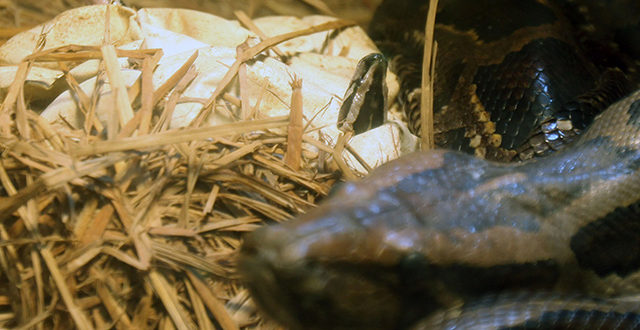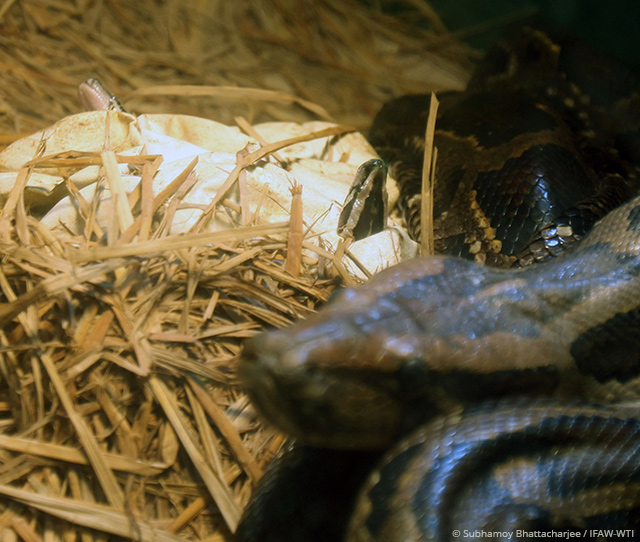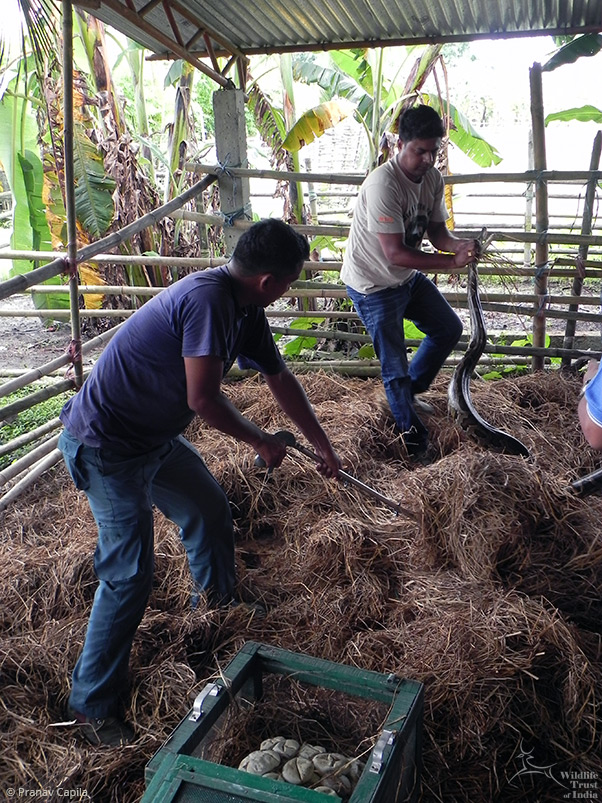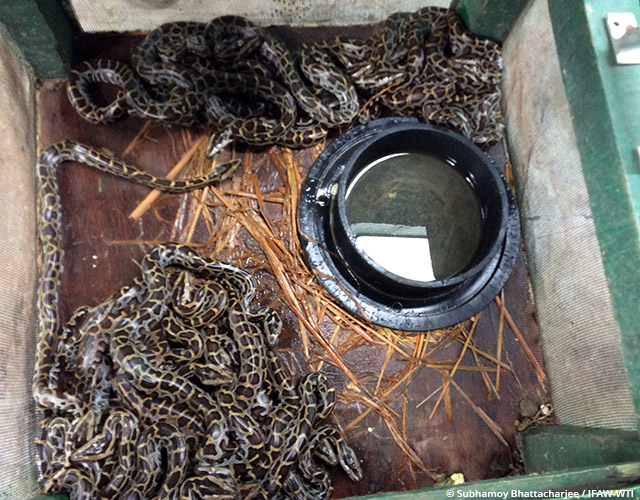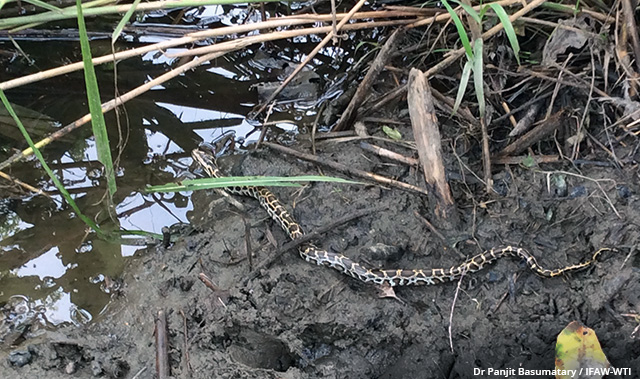One Rescue, 29 Lives
It was one of the happiest moments of my life: the sight of a tiny serpent head peeping out from a cracked eggshell in the makeshift incubation crate we had created for its giant mother and all her eggs.
The female Burmese python (foreground) and her eggs; the heads of two hatchlings can be seen
peeping out of their eggs in the background
Rage and Rescue
I had received a call the previous evening from Mr Joyram Baruah, Assistant Conservator of Forests, Jorhat, Assam, about a python that had been discovered brooding on her clutch of eggs at a remote ashram in the district. The ashram’s management had asked that the forest department provide some sort of expert resolution to the snake’s presence.
What sort of resolution, I wondered. Why would a non-poisonous constrictor concerned only with its eggs need rescuing? I decided that we must visit the ashram, if only to convince the management not to disturb the python – we would remove it and its neolates from the area once they hatched.
I left for the Jorhat Range Office at dawn, accompanied by animal keeper Raju Kutum. With forest officials in tow, we moved on to the Assam Bangiya Saraswat Math (aka Shanti Ashram), a sprawling establishment on the banks of the mighty Brahmaputra River. The head of the ashram took us to an outdoor shed used to store hay for the ashram’s cattle. Rain water had entered floor of the shed the previous evening, prompting workers to move the hay to a drier place, whereupon the brooding python had been discovered
Dr Samshul Ali (top) and Raju Kutum rescue the Burmese python. The eggs, already in a crate, can be seen in the foreground
A large crowd had gathered by the time we reached the spot and the python, or so we thought, had abandoned its nest. One of the eggs had also been broken open and the viable hatchling, a little Burmese python about 10 inches long, was lying nearby, killed — sources on the scene said by a local fisherman.
Now the Burmese python, I have to say, is my favourite constrictor. I have rescued several of them over the years and had performed a successful surgery on one earlier in June. It is a species whose population is dwindling fast, and it is protected under Schedule I of the Wild Life (Protection) Act of 1972.
My grief and rage at this wanton destruction of an innocent life threatened to boil over, but I forced myself to stay calm. I realised that the situation required a rescue; the area was far too disturbed, the eggs were viable and I could not leave them where they were. Raju and I, along with a forest department official, began to search for the mother. We found her soon enough, hiding under the hay near her eggs. We captured her and put her in a gunny sack, placed the eggs in a capture crate, and took them back with us to the Centre for Wildlife Rehabilitation and Conservation (CWRC), the wildlife rescue, treatment and rehabilitation facility run by Wildlife Trust of India (WTI), the International Fund for Animal Welfare (IFAW), and the Assam Forest Department in Panbari, Bokakhat.
The Hatching of New Hope
As soon as we reached CWRC, I, along with Dr Panjit Pasumatary (the centre’s lead veterinarian) and the animal keepers got started on the ideal enrichment of a glass-sided crate to serve as a makeshift incubation chamber. We decided to leave the mother with the clutch of eggs as a first option, hoping that she would brood. If she did not, we would have to consider artificial methods of incubation.
The crate was placed in a partitioned corner of the Small Animal Nursery and a 100-watt bulb provided for warmth. Fortunately, eight hours later, the mother coiled around her eggs and began to brood.
Now it was just a question of ensuring that the crate was left undisturbed as far as possible, and waiting. On July 10 we saw two patchy little heads begin to poke out of their shells. The entire team was elated! Over the next few days 26 little snakelets emerged from their eggs, one by one. (The mother python, having done her work, was released into the Panbari Reserve Forest on July 12.) As a final step we examined the unhatched eggs, some of them rotten by now, to see whether any snakelets could be saved. A couple of eggs had been compressed but seemed otherwise viable. We opened them surgically and extracted two snakelets, taking the final count up to 28!
My final act in this three-week drama came on July 16. Following discussions with the DFO, Eastern Assam Wildlife Division, I accompanied our MVS team, the Range Forest Officer of Kaziranga’s Western Range and other frontline forest staff to release the 28 snakelets into a woodland area in the Bagori Forest Range of Kaziranga National Park.
The author is a veterinary surgeon with the Centre for Wildlife Rehabilitation and Conservation.

